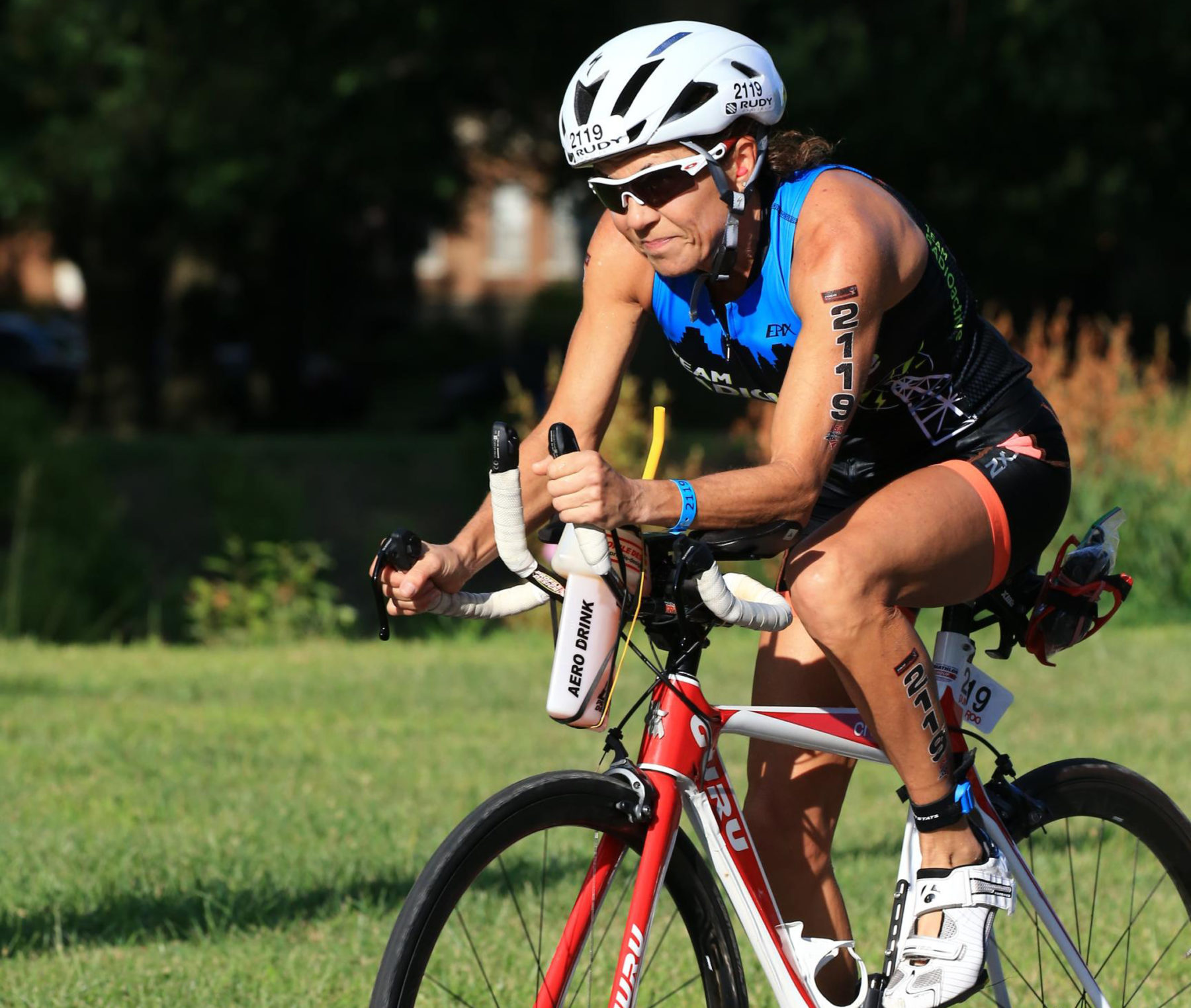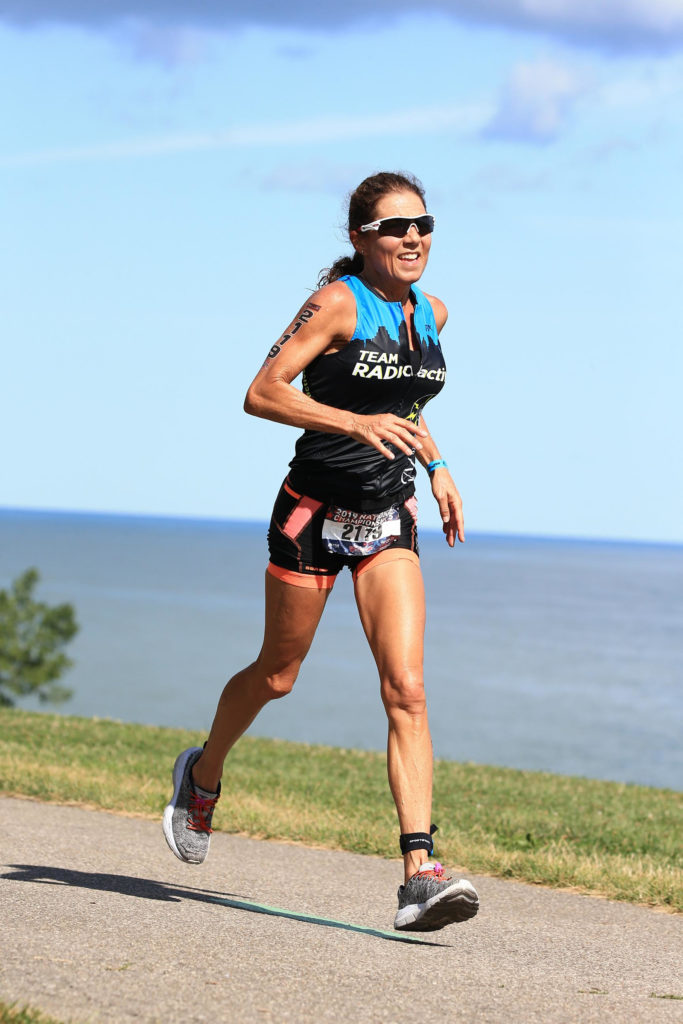Athlete Spotlight: Cynthia Salazar

Cynthia Salazar never dreamed she would have the opportunity to run an international race. As a local Austinite working full time and owning her own physical training business, at 40 she decided to compete in a triathlon. Over 10 years later, she is ranked ninth nationally in the 55-59 age group per USAT National Rankings, and she plans to keep going.
AFM: How did you get into triathlons?
CS: I was turning 40 and I decided for my 40th, I’m going to train for a triathlon — and that’s what I did. I started training when I was 39, found a program online — no coach, just me. I did the Tri CapTex and I won the masters. I was a nobody. I mean, no one knew me at all and I won masters. It was unbelievable.
AFM: How are you planning to improve your time for worlds?
CS: We have a swim time, a cycling time and a run time and transition times in between all three of those. The first transition slows me down because I have to get out of my wetsuit. When you come out from swimming, you still feel like you are in the wave wobbling around, and you’re trying to get this wetsuit off and it’s not working. I’ll go look at the girls who beat me and see what their transition times were and just ask myself, ‘How do they get out of their suit so fast?’ If I can just cut seconds off the transitions.
My weakest event is swimming, so I’ve been swimming a little more right now during the off-season. I think if I swim more, I’ll get fast. And I’m going to get someone to videotape me and watch my swimming style to see what I can do to improve my swimming.
The cycling — I don’t have huge legs. So, I’m never going to be the top cyclist. But for cycling, I’m pretty good because of all the exercises I do and the hills I do which is cycling in Colorado in the spring, so it really helps my race.
My running? I just have to make sure I do push myself in running a little bit, because if you don’t train your legs to spin faster, then they are not going to when racing. To do that, I hit the track and do a bit of fartlek runs, which is where you slow down then speed up. Right now, it’s focusing mostly on swimming. At Nationals, I was 30th coming out of the water out of 103. Coming off the bike, I was 16, so I caught up a little bit. Coming on the run, I finished sixth, so I had to do all my catch up on the bike and swim. But if I can get a little faster on the swim, I can catch up to second or third by the run.
AFM: Pre-race rituals?
CS: I always have dark chocolate and a glass of red wine before a race. Then, I get everything ready the night before. [Putting] Other things in separate bags so I know my bike and cycling stuff, my running stuff and swimming stuff is all set. The night before, I’ll have chicken with rice or quinoa and a vegetable. Usually that’s my pre-race dinner. I keep it kind of just simple.

AFM: What have you learned from triathlon racing?
CS: Self discipline is a big one, and gratification. And the experience of being able to compete with others in a friendly way. It’s funny, you’ll have somebody come up and say, “How old are you? Okay, you’re not my age group. Okay, good.” It’s funny. You meet a lot of people from all over. It’s the gratification to see other people finish and the looks on their faces. They may be walking or sprinting, but just to see the looks on their faces when they cross the finish line is pretty cool.
I have also learned through all these races to start listening to my body, because I’ve had so many injuries. I used to ignore them and keep pushing on and then something terrible would happen. So, listening to your body, for sure.
AFM: What are some challenges that you have faced training and competitively running triathlons?
CS: Stress fractures. I broke my leg back in 2016 in a race right before Nationals. Finding out I have osteoporosis — because of that, I am on a strict calcium protocol intake. I try to eat a lot of foods that have calcium in it, too. And I do resistance training to keep that up. So, that is the major obstacle right now.
AFM: How do you train for triathlons? How long are your workouts? What do you usually do to train?
CS: Very sporadically right now. I have a very full-time job that I’m basically on call 24/7, as well as my personal training business on the side. When it’s not training season, it’s a lot easier and I’m not getting up super early before I train my client and then before work. When I am in season, I sometimes have to get up even earlier to get a run in, shower and then go to one of my clients and then go to work.
Usually cycling will be my longest, so I have the indoor spinner I put my tri-bike on and that way, I’m still riding my bike. Those can go up to an hour and a half on the weekends. We will go on a Saturday morning ride for 52 miles on average. Sometimes for my runs, I’ll go out. If I don’t have time, I’ll go to do a quick three-mile run.
Most of the time during the weekday mornings, I’ll do a four- to four-and-a-half-mile run. Weekends, I’ll do a six- to eight-mile run. I don’t need to do any longer because my races are Olympic distance. Swimming, I’m usually in the pool 45 minutes to an hour. And then I’m spinning indoors 45 minutes to an hour and a half. Outdoors is usually two to four hours.
AFM: Where are some of your favorite places to train here in Austin?
CS: I like swimming at the Quarry, which is open water. I like running the Lady Bird trail because I can do the three, four, five, seven-mile loop depending on how much I feel like doing. And that can change once I start. I might feel good so I just extend with the seven-mile loop. The cycling I just enjoy, and I like it when we go to different places. I am never doing exactly the same route.






